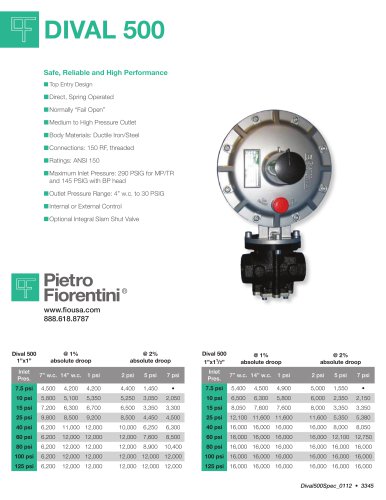
Catalog excerpts

Pressure Regulators
Open the catalog to page 1
Pressure regulators Integral Silencing Cage High Accuracy Dinamically Balanced Pilot
Open the catalog to page 2
Introduction Aperflux 101 is a boot style pilot-controlled pressure regulator for medium and high pressure applications. Aperflux 101 is normally a failed open regulator and specifically will open under the following circumstances: - breakage of main diaphragm; - lack of feeding to the pilot circuit. These regulators are suitable for use with previously filtered, non-corrosive gases. Designed With Your Needs In Mind - Compact Design - Easy Maintenance - Top Entry - Low Noise - High Turn Down Ratio - High Accuracy - Low Operation cost
Open the catalog to page 3
Main Features -Design pressure: up to 85 bar (1232,8 Psi) -Operating temperature: -10 °C to +60 °C (14 to + 140 °F) -Ambient temperature: -20 °C to +60°C (-4 to + 140 °F) -Range of inlet pressure bpu: 3 to 85 bar (43,5 to 1232,8 Psi) -Range of outlet pressure Wd: 2 to 74 bar (29 to 1073,3 Psig) depending on installed pilot -Minimum working differential pressure: 1 bar (14,5 Psi) - Recommended > 2 bar (29 Psig) -Accuracy class AC: up to 1 depending on the outlet pressure -Closing pressure class SG: 10 depending on the outlet pressure -Available size DN: 2” - 3” - 4” -Flanging: class 300-600...
Open the catalog to page 4
Aperflux 101 Choosing the pressure regulator Sizing of regulators is usually made on the basis of Cg valve and KG sizing coefficients (table 1). Flow rates at fully open position and various operating conditions are related by the following formulae where: Q = flow rate in Stm3/h Pu = inlet pressure in bar (abs) Pd = outlet pressure in bar (abs). A > When the Cg and KG values of the regulator are known, as well as Pu and Pd, the flow rate can be calculated as follows: A-1 in sub critical conditions: (Pu<2xPd) Q = KG x B > Vice versa, when the values of Pu, Pd and Q are known,the Cg or KG...
Open the catalog to page 5
Pressure regulators The formulae are applicable to natural gas having a relative density of 0.61 w.r.t. air and a regulator inlet temperature of 15 °C. For gases having a different relative density d and temperature tu in °C, the value of the flow rate, calculated as above, must be multiplied by a correction factor Fc, as follows: Table 2 lists the correction factors Fc for a number of gases at 15 °C. Table 2: Correction factors FC Type of gas Air Propane Butane Nitrogen Oxygen Carbon dioxide Caution: in order to get optimal performance, to avoid premature erosion phenomena and limit noise...
Open the catalog to page 6
Pilots System Pilots Aperflux 101 regulators are equipped with series 300 pilot as listed below: - 302/. control range Wd: 0.8 to 9,5 bar; (11,6 to 137,7 psig) - 304/. control range Wd: 7 to 43 bar; (101,5 to 623,5 psig) - 305/. control range Wd: 20 to 60 bar; (290 to 870,2 psig) - 307/. control range Wd: 41 to 74 bar; ( 594,6 to 1073,3 psig) Pilots may be adjusted manually or remotely as shown in table 3: Table 3: Pilot adjusting instructions Pilot type .../A Pilot type .../D Pilot type .../CS Manual setting Electric remote setting control Setting increased by pneumatic signal remote point...
Open the catalog to page 7
Pressure regulators In-line monitor The monitor is generally installed upstream of the main regulator. Although the function of the monitor regulator is different, the two regulators are virtually identical from the point of view of their mechanical components. The only difference is that monitor is set at a higher pressure than the main regulator. The Cg and KG coefficients of the regulator plus in-line monitor system are about 20% lower than those of the regulator alone. M/A Accelerator When the monitor is required to take over more rapidly in the event of a main regulator failure, an M/A...
Open the catalog to page 8
Installation Whenever Aperflux 101 pressure regulator is being installed, it is essential to follow a few basic rules in order to ensure the achievement equipment’s operational and performance characteristics. These rules may be summarised as follows: a) filtering: the gas arriving from the main pipeline must be adequately filtered; it is also advisable to make sure that the pipe upstream of the regulator is perfectly clean and void of residual impurities; b) pre-heating: whenever the pressure drop at the regulator is considerable, the gas must be pre-heated enough to avoid the formation of...
Open the catalog to page 9
Pressure regulators
Open the catalog to page 10
Overal dimensions in mm Size (mm) Inches A B C D (ANSI 300) D (ANSI 600) E F G H S (ANSI 300) S (ANSI 600) Weights in Kgf (with P302) ANSI 300 ANSI 600 Face to face dimensions S according to IEC 534-3 and EN
Open the catalog to page 11
Pietro Fiorentini S.p.A. via E.Fermi 8/10 I-36057 Arcugnano (VI) Italy via Rosellini 1 I-20124 Milano Italy
Open the catalog to page 12All PIETRO FIORENTINI catalogs and technical brochures
-
Dival-SQD
16 Pages
-
Dival 700
20 Pages
-
Dival 600
8 Pages
-
Dival 507/512
12 Pages
-
Dival 500
12 Pages
-
DIVAL 500_Flyer
1 Pages
-
Aperval
12 Pages
-
Aperflux 851
2 Pages









